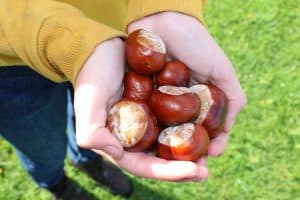In this section, we provide some help and guidance on how to get started with teaching mathematics in the outdoor environment. It may take time to develop your practice and so be realistic about what you can achieve, particularly if you are introducing some outdoor mathematics activities for the first time - the most important thing is just to start!
Be realistic
 Start with something simple. Some of our activities include tasks that you may have previously completed indoors. For example, activities such as ‘Zeds’, ‘Sequence of Stars’ and ‘Tables and chairs’ use natural resources to investigate patterns; the ‘Probability Walk’ activity uses an outdoor walk to explore probability and has a recording sheet to structure student work. Other activities involve a wider range of mathematical concepts and may take place over an extended period of time. For example, ‘Garden designs’ challenges children to design a garden area for the school grounds, incorporating length, scale, area and perimeter with opportunities for further activities relating to budgeting and the use of spreadsheets. Trialling less complex activities initially will help to build your confidence and competence.
Start with something simple. Some of our activities include tasks that you may have previously completed indoors. For example, activities such as ‘Zeds’, ‘Sequence of Stars’ and ‘Tables and chairs’ use natural resources to investigate patterns; the ‘Probability Walk’ activity uses an outdoor walk to explore probability and has a recording sheet to structure student work. Other activities involve a wider range of mathematical concepts and may take place over an extended period of time. For example, ‘Garden designs’ challenges children to design a garden area for the school grounds, incorporating length, scale, area and perimeter with opportunities for further activities relating to budgeting and the use of spreadsheets. Trialling less complex activities initially will help to build your confidence and competence.
Be prepared
 As with indoor lessons, careful organisation of resources is vital to ensuring that the activity goes smoothly. Think through what resources are needed and how they will be brought outside and made accessible to the children. Do not be afraid to improvise or make amendments to the resources that have been suggested. You may need to consider the seasons, particularly when it comes to using natural resources. For example, activities that involve using conkers may need to be adapted if carried out in the summer time.
As with indoor lessons, careful organisation of resources is vital to ensuring that the activity goes smoothly. Think through what resources are needed and how they will be brought outside and made accessible to the children. Do not be afraid to improvise or make amendments to the resources that have been suggested. You may need to consider the seasons, particularly when it comes to using natural resources. For example, activities that involve using conkers may need to be adapted if carried out in the summer time.
Be flexible
 The activities provide guidance on how to progress learning. They may need to be adapted to suit the age, ability and interests of your children as well as your learning environment. It is important to think through all phases of the activity and make decisions that best suit your circumstances. Some activities may be carried out in one lesson; others may be better developed over a period of time. It is envisaged that most of the learning will take place outdoors. It would be helpful to have an outdoor classroom and/or an outdoor board to facilitate whole class introductions and plenaries and for small group discussions. However, this may not be possible in your setting. In such cases, it may be more appropriate to move between the classroom and the outdoors at different phases of the activity.
The activities provide guidance on how to progress learning. They may need to be adapted to suit the age, ability and interests of your children as well as your learning environment. It is important to think through all phases of the activity and make decisions that best suit your circumstances. Some activities may be carried out in one lesson; others may be better developed over a period of time. It is envisaged that most of the learning will take place outdoors. It would be helpful to have an outdoor classroom and/or an outdoor board to facilitate whole class introductions and plenaries and for small group discussions. However, this may not be possible in your setting. In such cases, it may be more appropriate to move between the classroom and the outdoors at different phases of the activity.
Recommended resources
While it is possible to lead outdoor learning activities with minimal resources, there are certain resources that are worth investing in as they can be used regularly for multiple different activities. It could be useful to have a mathematics trolley or a mathematics station available for outdoor activities.
- Outdoor board
- Clipboards
- Playground chalk
- A camera
- Timing devices
- Measuring tools such as rulers, tape measures, metre sticks and trundle wheels
Other natural resources such as conkers or sticks can be gathered over time so that they can be used in outdoor lessons.
- Conkers
- Sticks
- Pebbles
- Shells
- Pine cones
Small adaptions, such as painting markings on the school playground can be very useful for outdoor learning in mathematics and can be used in different ways and for different purposes.
- Number tracks
- Number lines
- 10 x 10 grid
- Coordinate grid
- Compass rose
Key benefits of outdoor learning in mathematics
It is widely established that outdoor learning experiences have a positive impact on children’s holistic development. High-quality outdoor learning experiences have the potential to:
- Promote children’s physical and mental health and wellbeing
- Develop children’s personal and social skills
- Enhance children’s knowledge, skills and understanding across the curricular areas
 Despite the many benefits of learning in the outdoor environment, there is evidence to suggest that today’s children are spending less time outdoors than the children of previous generations. There also appears to be a decline in the provision of outdoor learning experiences between the early years and later stages of education, with some teachers attributing this to the increased emphasis on test-based accountability, particularly in core curricular areas.
Despite the many benefits of learning in the outdoor environment, there is evidence to suggest that today’s children are spending less time outdoors than the children of previous generations. There also appears to be a decline in the provision of outdoor learning experiences between the early years and later stages of education, with some teachers attributing this to the increased emphasis on test-based accountability, particularly in core curricular areas.
These activities have been designed to support the delivery of the curriculum in upper primary classes, by integrating outdoor learning experiences within the core area of mathematics. Teaching mathematics in the outdoor environment offers a wide range of benefits, including:
- Provides a meaningful context for learning mathematics
- Helps to make mathematics real and relevant
- Deepens understanding of mathematical concepts
- Engages children in learning
- Helps to promote a positive attitude towards mathematics
Testimonials
Looking for inspiration? Watch the videos about the experiences of some our participants below.
- Sharon Graham from Killylea Primary School shares her experiences of teaching mathematics outdoors.
- Jennifer Holligan from St Conan’s Senior National School speaks of her journey in getting started with outdoor learning in mathematics.
